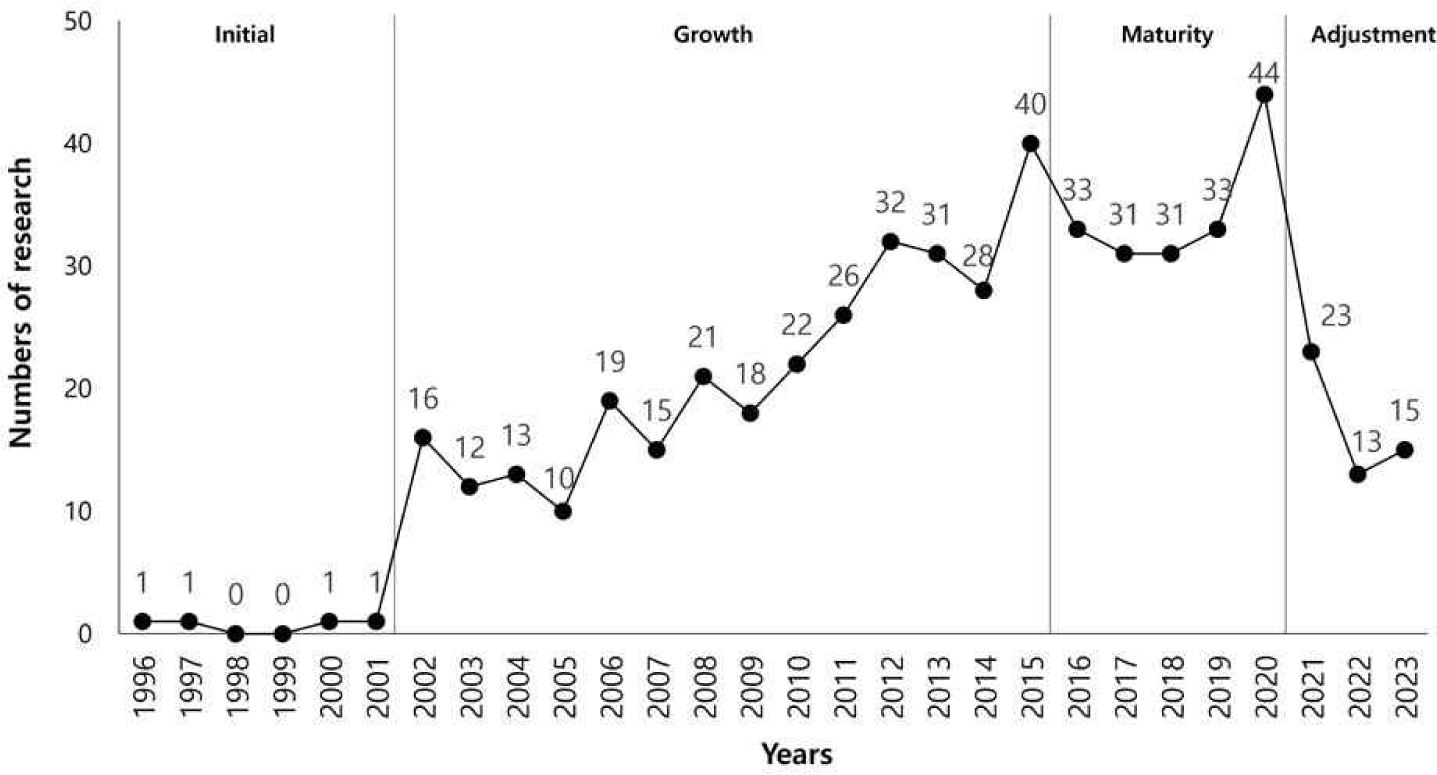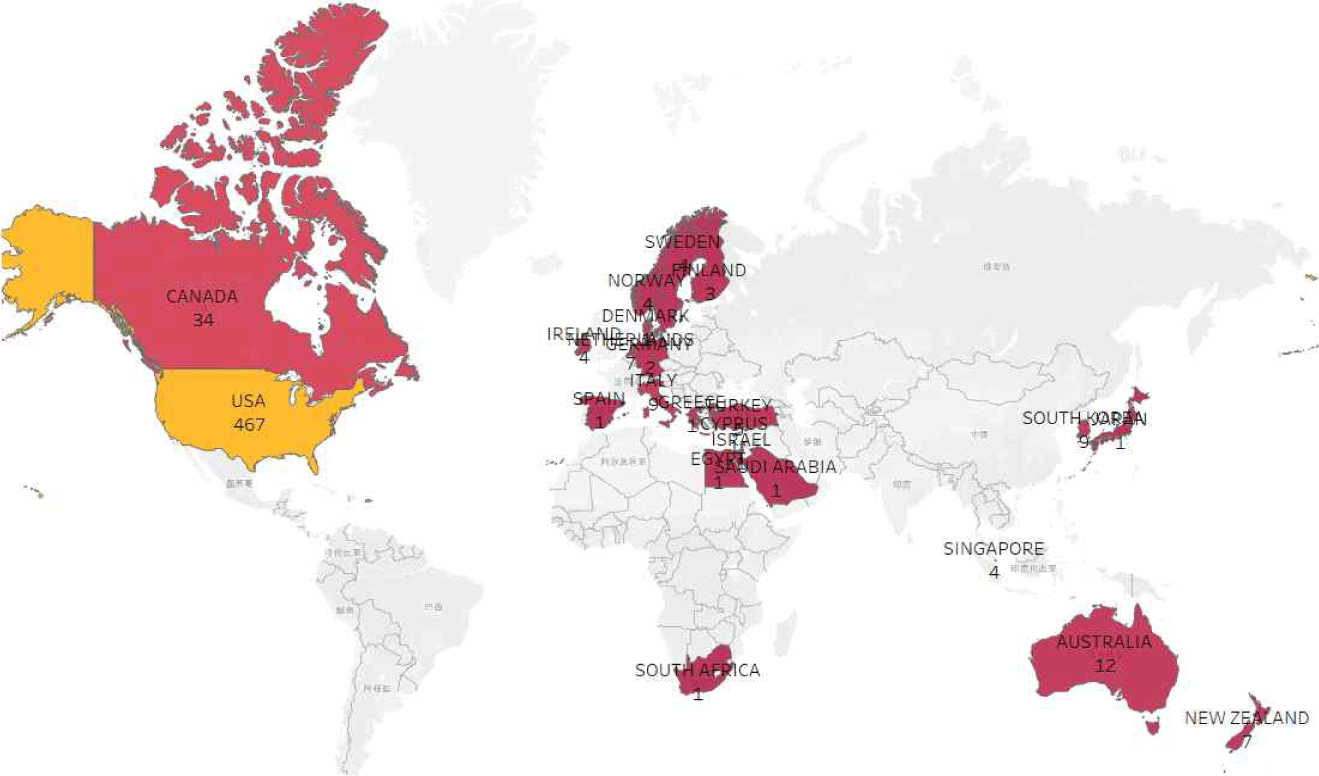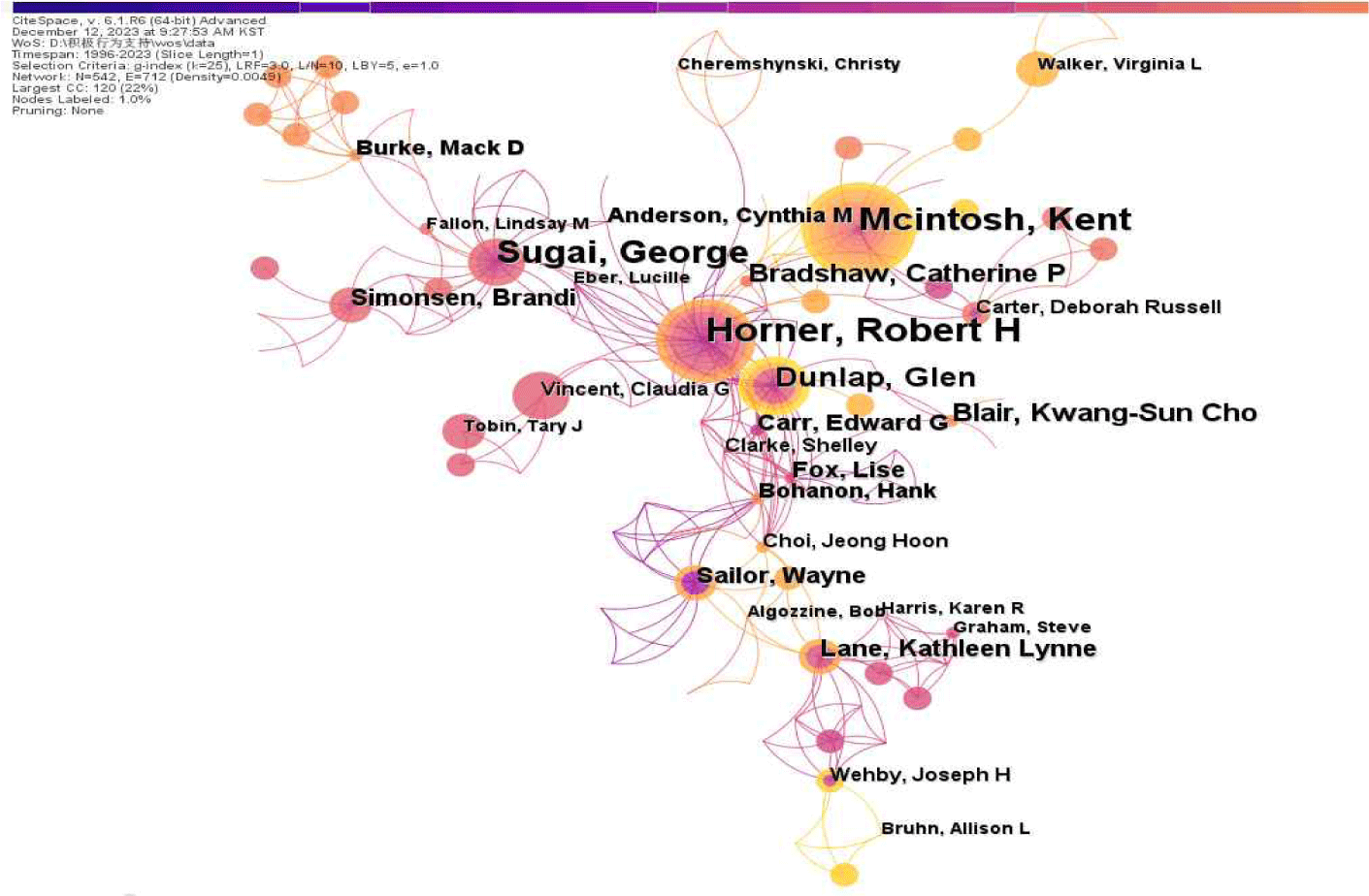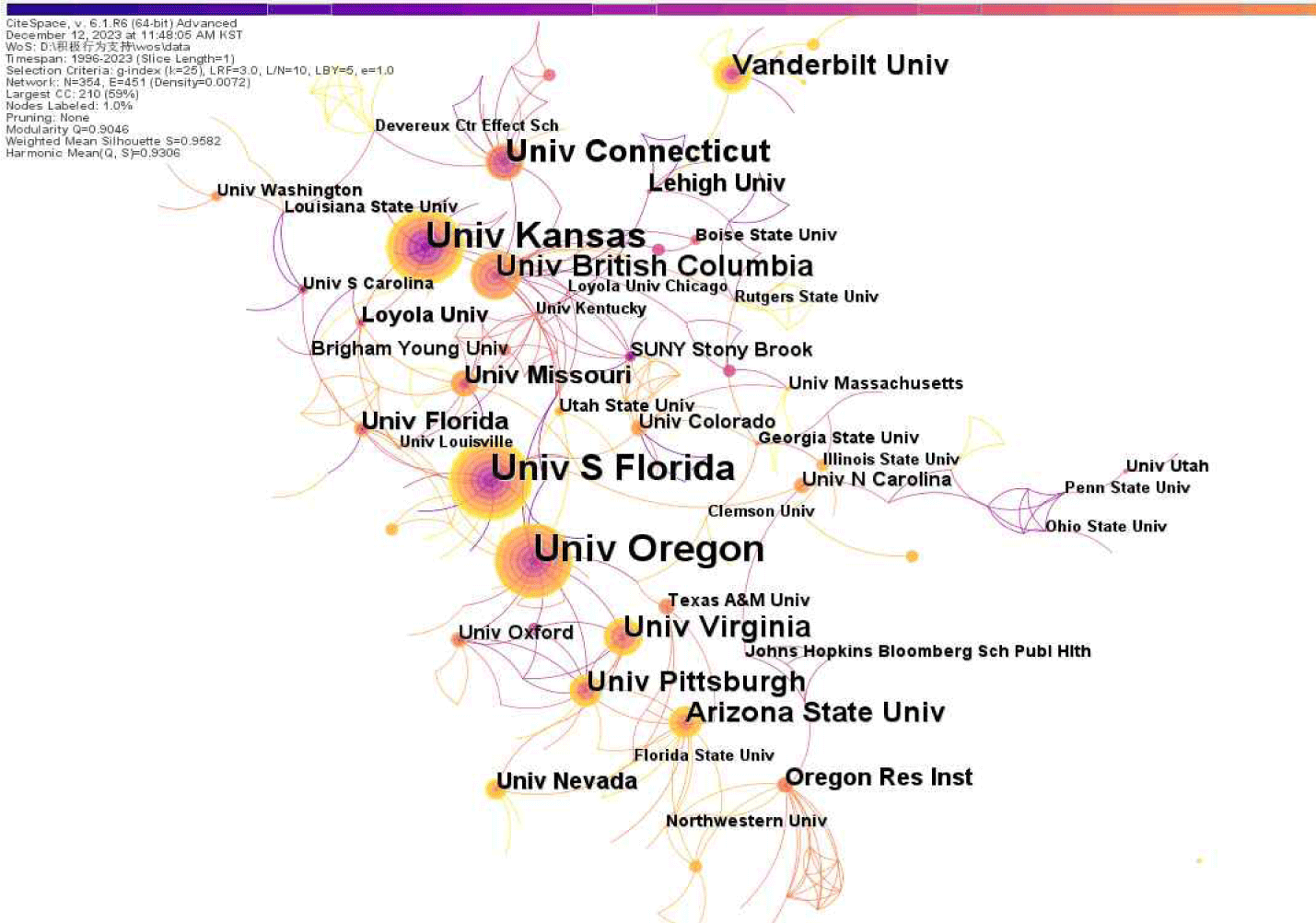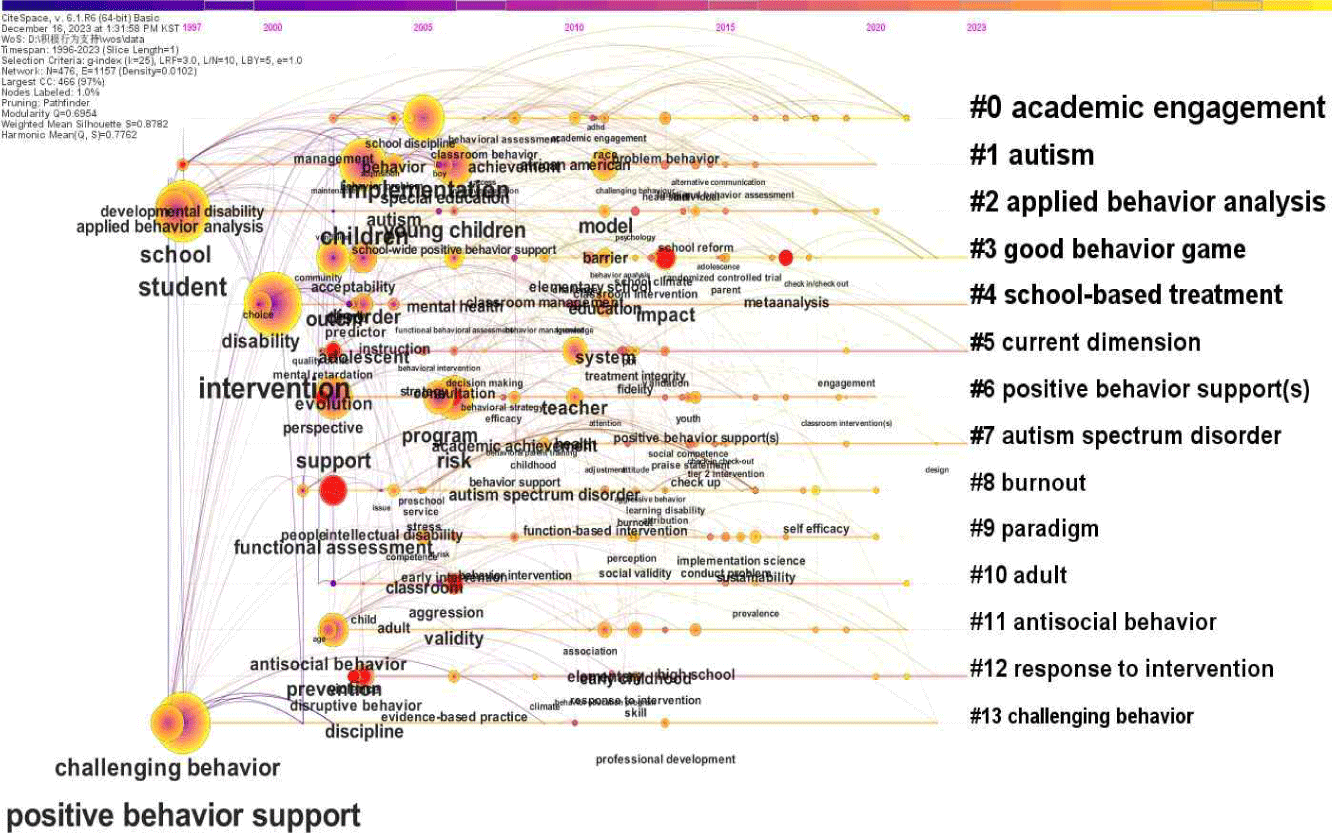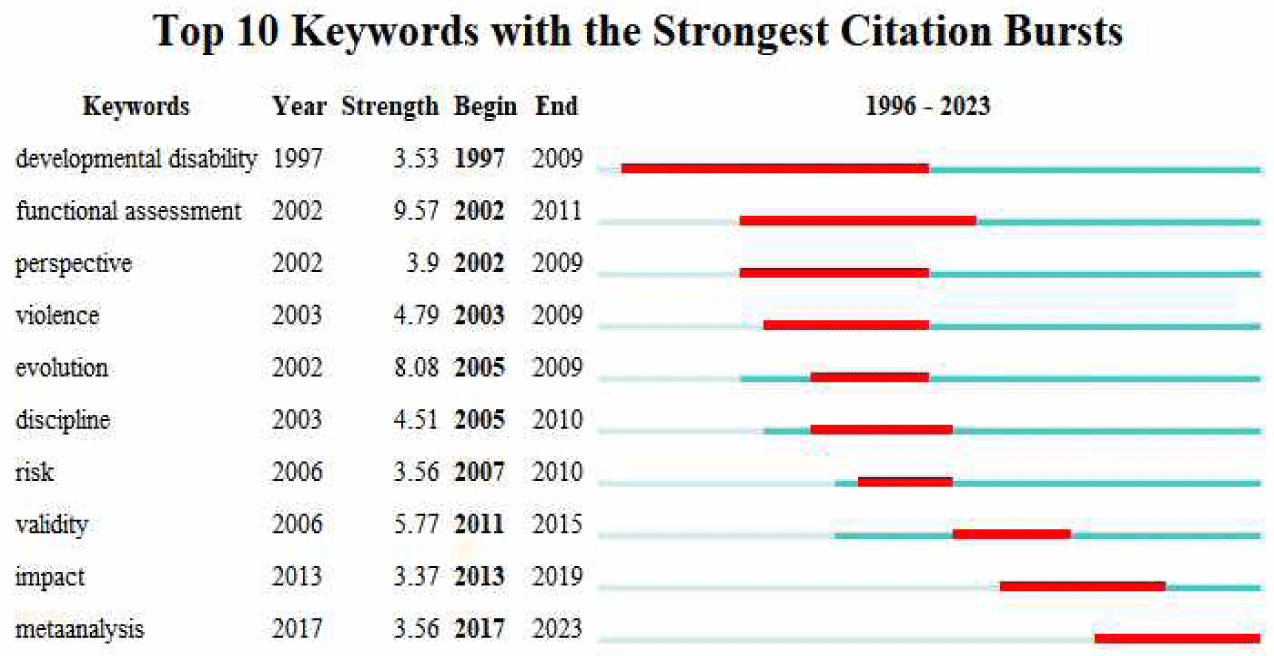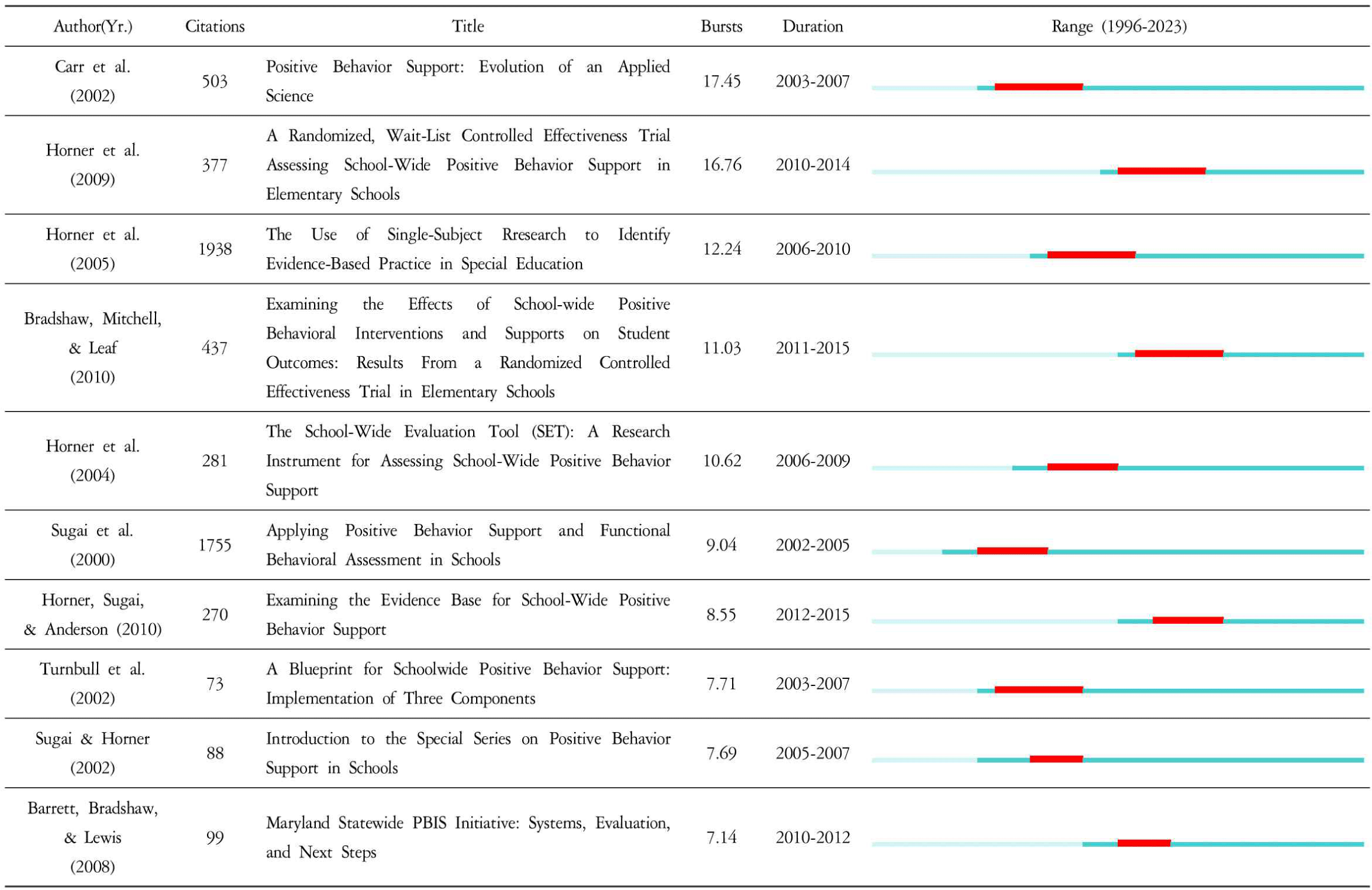I. Introduction
Positive Behavior Support (PBS) emerged in the mid-1980s as a methodology for understanding and addressing problem behavior. Originating from Applied Behavior Analysis (ABA), it is based on person-centered values, with educational methods such as environmental redesign used to improve quality of life or reduce challenging behavior (Carr et al., 1999; Dunlap et al., 2008; Weigle, 1997). Since the enactment of the Individuals with Disabilities Education Act (IDEA) in the United States in 1975, the scope of the PBS application has broadened to various settings (including schools, homes, and communities). It is applicable to students both with and without disabilities, as well as a wide range of social and academic challenging behavior. More importantly, the focus of the PBS approach has shifted from individual case management to system-wide implementation, particularly for entire school systems (Lewis & Sugai, 1999; Sugai & Horner, 1999).
The key features of this method include: (a) research-based assessment, intervention, and data-driven decision-making; (b) building social and other functional skills, creating a supportive environment, and preventing challenging behavior; (c) respecting the dignity and overall well-being of individuals or groups; (d) embracing data from various fields and evidence-based programs; and (e) application at both the individual and broader system levels, such as families, classrooms, schools, social service programs, and facilities, within a multi-tiered framework (Kincaid, 2018). PBS is considered comprehensive, systemic or personalized support to prevent challenging behavior and achieve important social and learning outcomes (Sugai & Horner, 2002). It emphasizes the prevention of negative behaviors rather than a mere reaction to already occurring behaviors. Continuous monitoring and evaluation of implemented strategies are essential to ensure their effectiveness, with adjustments made as necessary.
PBS is an evidence-based tiered framework designed to support students’ behavior, academics, and social, emotional, and mental health. PBS focuses on continuous, preventative support, described across three tiers. Tier 1 prevention provides support to everyone in the school environment (students, educators, and staff) to enable success for the majority (80% or more) of students. Tier 2 prevention offers additional guidance and behavioral support for a subset (10%-15%) of students exposed to a significant risk of academic failure and requires more specialized support than what primary prevention provides. Tier 3 prevention supports a minority (1%-5%) of students for whom Tier 1 and Tier 2 support prove insufficient. These students are at risk of severe emotional, behavioral, and social failures and require more intensive and individualized support (National Technical Assistance Center on Positive Behavioral Interventions and Support, 2023).
Over the past decade, research on PBS has confirmed the positive impact of its three-tier system and practices on the enhancement of student outcomes. Firstly, PBS implementation has reduced disciplinary actions and inequities among students. It has decreased disciplinary inequities for students with disabilities (Bradshaw, Waasdorp, & Leaf, 2015), as well as lowered the rates of academic referrals (Farkas et al., 2012; Johnson et al., 2013) and expulsion rates among students with disabilities (Gage et al., 2018). Secondly, PBS has improved social, emotional, and behavioral competencies among students. Studies indicate that elementary students are more likely to exhibit prosocial behaviors and emotional regulation after PBS implementation (Ohkubo et al., 2022). Furthermore, in secondary schools, teachers reported an increased academic engagement when Tier 2 PBIS efforts were incorporated into a solid Tier 1 foundation (Van Camp et al., 2021). Thirdly, PBS implementation has led to reductions in students’ disruptive behaviors. After PBS implementation, aggressive behaviors and inappropriate behaviors among preschool children have decreased (Feil et al., 2009; Hemmeter et al., 2016; Park & Shim, 2021), and elementary students also show reductions in aggressive and disruptive behaviors (Ward & Gersten, 2013; Wu et al., 2019). In secondary school settings, inappropriate behaviors decreased after PBS implementation (Flannery et al., 2014; Oswald, Safran & Johanson, 2005; Solomon et al., 2012). Furthermore, teachers in secondary schools reported a decline in disruptive behavior when Tier 2 PBIS efforts were incorporated into a solid Tier 1 foundation (Van Camp et al., 2021). Fourthly, PBS implementation has enhanced teacher efficacy and proactive behavior support. Studies indicate that elementary school teachers improved their skills in proactive behavior management after PBS implementation (Condliffe et al., 2022; Sørlie, Ogden & Olseth, 2016). Research has also confirmed improved teacher self-efficacy after PBS implementation (McIntosh, 2023; Park, Lee, & Kim, 2019; Ross, Romer, & Horner, 2012).
The positive impact of PBS on students has been widely recognized. However, there is currently a relative scarcity of bibliometric research in the field of PBS. The application of bibliometrics, including citation network analysis, co-word analysis, and other techniques, can effectively construct a knowledge map within the field, revealing the knowledge structure, development trajectory, and core literature of the discipline. This methodology is of significant value in helping researchers quickly grasp the current status and development trends in the field of Positive Behavior Support. Given the rapid advancement in PBS research, a detailed analysis of its spatial-temporal distribution, knowledge base, research hotspots, and emerging trends may be useful to identify key patterns, assess the current state of knowledge, pinpoint active research areas, forecast future developments, and facilitate effective collaborations and funding decisions(Chang et al., 2023; Khalique et al., 2020; Man, Wang, & Yang, 2021).
This study employs bibliometric methods to conduct an in-depth visual analysis of the most influential literature in the field of PBS over the past thirty years. By exploring global publication volume, research contributions from different countries, the roles of major authors and institutions, the evolution of key words, and the impact of landmark literature, this research offers an intuitive and comprehensive perspective. This enhances understanding of the knowledge development paths and trends in the field, thereby providing data support and insights for subsequent research efforts.
II. Research Methods
The bibliometrics analysis method was applied to the research method of this study. Bibliometrics is a discipline that applies mathematical and statistical methods to analyze and interpret literature information(Lawani, 1981). It is commonly used to quantify research activities and trends within scientific fields, revealing the development dynamics, research hotspots, academic influence, and knowledge structure and flow of a particular area or discipline by studying the production, distribution, attributes, and relationships of literature. This involves the statistical and evaluative analysis of various indicators related to literature (such as journal articles, conference papers, patents, etc.), including publication volume, citation counts, collaboration patterns, keywords, and subject trends. This study employs bibliometric methods to statistically analyze aspects such as the publication volume, researchers, research institutions, and research hotspots within PBS research.
This study utilizes the CiteSpace information visualization software for bibliometric analysis of the literature. CiteSpace is a tool for visual analysis and research on academic literature within various research fields or disciplines (Chen, 2006, 2020). The CiteSpace information visualization software mainly relies on theories like Co-citation Analysis and algorithms such as Pathfinder Network Scaling (PF-NET) to conduct bibliometric analysis of specific field literature (collections). Through this process, the aim is to uncover the key paths and intellectual turning points in the evolution of a discipline. Through a series of map drawings, CiteSpace helps form the potential dynamic mechanisms of discipline evolution and detect the frontiers of discipline development (Chen, 2004).
The following parameters were applied: Time Slicing was set to 1996-2023, Years Per Slice to 1, and Node Types to Author, Institution, Country, Keyword, and Cited Reference. The Selection Criteria was set to Top N, with a value of 50, indicating that the top 50 frequently appearing nodes were selected in each time zone. The pruning methods used were pathfinder and pruning of the merged network. Node types were flexibly selected for analysis based on the research content.
The literature data for this study were obtained from the Web of ScienceTM (WoS, webofscience.com), a large, comprehensive, multidisciplinary database with over 12,000 authoritative and high-impact academic journals across fields such as natural sciences, engineering technology, biomedical sciences, social sciences, arts, humanities and so on. In this study, databases selected from the literature include the Web of Science Core Collection, with “Editions” chosen as the Science Citation Index Expanded (SCI-EXPANDED) and the Social Sciences Citation Index (SSCI). The search topic was “Positive Behavior Support” OR “Positive Behavior Support PBS,” with publication dates spanning all years, and the search was conducted on December 11, 2023. The initial search yielded 608 documents. After refining the literature by selecting document types as Journal Articles and Review Articles, language as English, and excluding documents not relevant to the topic, a total of 530 search results were obtained. Data were downloaded and saved as plain text files in the same folder.
When analyzing with CiteSpace software, during the “Project” creation process, one can directly select the folder path where the data is saved. For data time segmentation, we chose a “Time Slicing” value of 1, meaning each year was taken as a time interval. This approach to time-segmenting the data was primarily due to two considerations: firstly, the principle of the “divide and conquer strategy” adopted by CiteSpace in its design and operational process facilitates the software’s running speed and accuracy; secondly, segmenting the data helps identify significant turning points in the discipline’s evolution and the development patterns of research frontiers. Data conversion and deduplication were conducted using CiteSpace-Data-Import/Export-WoS-Duplicate Removal.
III. Results and Interpretation
The changes in the number of publications on PBS reflect the research development during this period. Figure 1 shows an exponential growth trend in PBS research. Influential research began in 1996 and showed a slow growth trend until 2001, when one or fewer papers were published each year. From 2002 to 2015, research on PBS showed a wave-like growth trend. From 2016, it maintained a relatively large quantity until 2020, when the number of publications surged to 44. Since then, publications have fallen sharply since 2021. Therefore, research on PBS can be divided into four stages: (i) the initial period from 1996 to 2001; (ii) the growth period from 2002 to 2015; (iii) the maturity period from 2016 to 2020, and (iv) the adjustment period from 2021 to the present.
Currently, various countries are implementing PBS with their own methods, and related research appears to be in a diffusion phase. However, due to the COVID-19 pandemic, the face-to-face support approach of PBS might have waned, leading to a downturn in PBS research after 2020. Considering the diffusion of results to different countries, one might have expected South Korea to actively conduct research after 2020. There has not been much research in this area post-2020 (Kim, Choi, & Yun, 2023). Therefore, this result corroborates the notion that the COVID-19 pandemic has led to a contraction in the face-to-face support approach of PBS.
However, the COVID-19 pandemic situation has created an opportunity to test new ways of implementing PBS. The COVID-19 pandemic situation has interested researchers in research that applies virtual simulation methods in behavioral analysis methods (Baek, 2021), and has led various countries to leverage technological innovations for support, and to explore methods of PBS, such as simulating face-to-face interactions using VR and AR technologies, and improving interaction and engagement (Farella et al., 2021). To strengthen behavioral support networks, online support systems have been strengthened by creating online teams, online support intervention meetings, and online courses (Degli Espinosa et al., 2020; Frederick et al., 2020; Hayward et al., 2022; Hier et al., 2024).
Figure 2 shows the country distribution of PBS research, with a total of 29 countries represented. Table 1 lists the top 20 countries in terms of publication volume. The United States leads with 467 publications, with the top position in this research field. Following is Canada, with 34 publications, and the United Kingdom ranks third with 14 publications. This is followed by Australia with 12 publications, South Korea with 9 publications, among others. Centrality refers to the capacity of being a mediator in the entire relational network (Chen, 2020). Nodes with a centrality greater than 0.1 are generally considered to hold significant influence in the network structure (Fang, Yin, & Wu, 2018; Zou, Yue, & Le Vu, 2018). The countries with significant influence in PBS research are the United States(Centrality=0.45) and the United Kingdom (Centrality=0.16). Although Canada has a high number of publications, its centrality is lower, indicating that its influence is not as great as that of the United States and United Kingdom. Therefore, the United States holds a leading position in the field of PBS research.
The United States is a front runner in PBS research. This leading position is partly due to its strong support for special education and behavioral interventions through national policies. The Individuals with Disabilities Education Act (IDEA), passed in 1975, ensured that all students with disabilities receive an Individualized Education Program (IEP), promoting the development of various educational intervention measures including PBS (U.S. Department of Education, 2017). Moreover, the Every Student Succeeds Act (ESSA) was enacted in 2015, encouraging the use of evidence-based interventions to enhance student learning outcomes, including support for students with behavioral and learning challenges (U.S. Department of Education, 2015). These policies not only provide financial support but also encourage academic research and practical innovation, further advancing the development and application of PBS strategies. In addition, with the support of the U.S. Department of Education, the National Technical Assistance Center on Positive Behavioral Interventions and Support (PBIS) was established to help improve the social, emotional, behavioral, and academic outcomes for students, families, and educators(National Technical Assistance Center on Positive Behavioral Interventions and Support, 2023).
Research related to PBS is being actively conducted in most advanced the western countries, including the North America. On the other hand, in Asia, Korea’s 5th place indicates that PBS is showing strength in Korea.
The reasons for this strong performance in research related to PBS in Korea are as follows. First, it is the government’s support. The government’s behavioral support policy for special education recipients is being actively implemented in three aspects: team-based positive behavioral support, support for human and material resource and policy operations, and support for member competency building (Park, 2021). Second, it is the effort of research institutes. Behavioral Analysis Research to implement PBS is systematically being conducted. In Korea, the Korean Association for Behavioral Analysis(KABA, kaba.or.kr) was established in 2013 with the main research topics of Applied Behavioral Analysis(ABA) and PBS and is publishing a journal called “Journal of Behavior Analysis and Support”. This journal is recognized as the Korea Citation Index (KCI) of the Korea Research Foundation in 2020, and has been producing PBS-related research every year (Baek & Park, 2020). In addition, the KCI Impact Factor(IF) as of 2022 is 2.20, which is higher than the average IF(1.92) of pedagogical-related publications. Third, it is spreading to related institutions. It is actively considering the introduction of positive behavioral support in the field of special education practice. PBS are actively introduced in practice sites such as residential facilities for the disabled and day care centers, and through this, applicability to the field is increasing (Bang & Lee, 2021; Kim & Jung, 2018).
Authors collaboration map analysis can recognize key authors and the intensity of cooperation in specific fields (Wu & Lee, 2022). Bibliometric analysis of the publication volume of authors not only helps understand core authors in PBS research but also reveals academic exchanges and collaborations in the field. Figure 3 displays the publication volume and collaboration among authors, with the number of publications represented by the size of the nodes; larger nodes indicate a higher number of publications. Collaborations between authors are shown through lines, with a total of 712 links indicating close collaborations among authors. Horner, Sugai, and McIntosh exhibit many connecting lines between them, forming a core group of authors. Table 2 lists the top 5 authors in terms of publication volume. Horner leads with 18 publications, followed closely by McIntosh. McIntosh with 17 publications, Sugai with 14 publications, and Dishion with 13 publications, and Dunlap with 12 publications.
| Ranking | Author | Year | Count |
|---|---|---|---|
| 1 | R. H. Horner | 2007 | 18 |
| 2 | K. McIntosh | 2009 | 17 |
| 3 | G. Sugai | 2008 | 14 |
| 4 | T. J. Dishion | 2008 | 13 |
| 5 | G. Dunlap | 2006 | 12 |
PBS emerged in the mid-1980s, and since then, there has been an explosive growth in related research, concepts, and interventions in PBS (Carr et al., 1999). Horner et al. (1990) used “nonaversive” behavioral support techniques to intervene in challenging behavior, with an emphasis on the role of social acceptance and dignity in behavioral support to further clarify PBS. Weigle (1997) regarded PBS as a model for effective behavior management and the promotion of inclusive education in school environments, stating the need for systemic adjustments and administrative support to ensure successful implementation. Lewis and Sugai(1999) introduced Effective Behavioral Support (EBS) as a Multitiered System of Support (MTSS), highlighting it as a systematic approach to enhance effective behavioral support for all students in schools. On this basis, Sugai and Horner (2002) further clarified the characteristics of PBS, emphasizing its focus on continuity of support for prevention, an active and positive teaching approach; it is a practice sound in concept and experience (e.g., PBS practices are based on the conceptual logic and empirical foundation of Applied Behavior Analysis theory); and it is based on data-driven decisions (e.g., using data to determine the priority of behavioral interventions, evaluate the effectiveness of interventions, set intervention goals).
McIntosh has conducted extensive research on SWPBS, using various methods such as the recording of Office Discipline Referrals (ODRs), a systematic tool for documenting serious behavior incidents. This tool is utilized in the implementation of SWPBS to identify individual students who may require additional support (McIntosh et al., 2009). McIntosh et al.(2013) analyzed factors influencing the sustained implementation of SWPBS, including both school-level and district-level factors. Their findings suggest that school administrators ensure regular team meetings and access to high-quality data to support the SWPBS system. District administrators, on the other hand, can provide training and support at the school level by offering district guidance, ongoing professional development, and community connections. These efforts aim to cultivate effective school teams and the capacity to provide optimal support for schools. McIntosh et al. (2018) conducted a three-year study on the extent to which variables at the school level, practice level, and district level predict the sustained implementation of Tier 1 (universal level) of SWPBIS in schools at different stages of implementation.
The study found that in the first year, sufficient implementation fidelity and the effective utilization of data for decision-making by school teams were the strongest predictors of sustained implementation by the third year. Additionally, the number of other schools within the district adopting SWPBIS was also a strong predictive factor.
Figure 4 displays the distribution of research institutions involved in PBS studies, where larger nodes indicate a higher number of published papers from the institutions. Meanwhile, Table 3 shows the institutions with a centrality greater than 0.1 in terms of publication influence, indicating significant international influence in PBS research. Topping the list is the University of Oregon (67 publications), followed by the University of British Columbia (26 publications). Close behind are the University of Florida (13 publications), the University of Kansas (47 publications), the University of South Florida (50 publications), the Midwest PBIS Network (1 publication), and the University of Pittsburgh (19 publications). It can be observed that among the top 7 influential institutions, 6 are situated in the United States, with only 1 from Canada. Notably, despite only one publication, the Midwest PBIS Network exhibits significant influence.
Midwest PBIS Network serves as a national-level research, funding, and direct financial support institution in the United States. Its primary role is to act as a hub for the PBIS Center, which is funded by the U.S. Department of Education. The goal of PBIS Center is to create a safe, equitable, and positive learning environment for all youth, facilitating their success across social, emotional, behavioral, and academic aspects. Currently, Midwest PBIS Network provides technical assistance activities to over 1,100 schools in Illinois that are implementing PBIS (Midwest PBIS Network, 2023). Researchers affiliated with the center, such as Weist et al. (2018), have studied the adjustment of Positive Behavior Interventions and Supports (PBIS) and the expansion of School Mental Health (SMH) support within the Interconnected Systems Framework (ISF). They focused on MTSS to improve the support system for students with internalized emotional and behavioral issues, such as depression, anxiety, and post-traumatic stress disorder. Through their work, they provide guidance for the resolution of internalized emotional and behavioral problems of students.
Research hotspots refer to topics or issues that currently receive high attention and active research within the academic and practical communities. They reflect the concentration of scientific resources, the level of academic discussion, and the urgency of societal needs(Chen, 2020). Research hotspots analysis refers to the investigation of popular issues or topics within a certain period, characterized by a group of research papers with a relatively large number and intrinsic connections. The frequency distribution of keywords in literature can be used to study the development trends and research hotspots in a field (Gong, 2019). Keywords offer a rapid insight into the main content of a literature piece, and their analysis facilitates the grasp of research hotspots in the field (Chen, 2017). Understanding research hotspots can help educators identify and adopt the most effective strategies and methods to support students’ behavior and learning. Teachers can promote a more positive and supportive learning environment by implementing intervention measures supported by the latest research.
In this study, keywords were used as node types to identify research hotspots, resulting in 1157 nodes and 467 links. As shown in Figure 5, the larger the node, the higher the frequency of the keyword’s occurrence. Excluding “Positive Behavior Support,” which has the highest word frequency, other keywords appearing more than 40 times include intervention (170 times), student (98 times), children (77 times), implementation (72 times), challenging behavior (60 times), school (51 times), young children (46 times), support (42 times), and risk (41 times). This indicates that in PBS research, the hotspots are focused on areas such as intervention, student, children, implementation, and challenging behavior.
Furthermore, keyword co-occurrence acts as a bridge connecting different research hotspots. Its manifestation lies in the number of links between nodes; the greater the number of links a node has, the higher its centrality and the more significant its role in the entire research network (Chen et al., 2012). As shown in Table 4, based on the statistical analysis conducted by the software, keywords with a centrality greater than 0.1 are as follows: disability, challenging behavior, applied behavior analysis, people, developmental disability, aggression, disorder, antisocial behavior, mental health, and behavior problem. This indicates the significant role of these keywords in the research hotspots of PBS.
Research frontiers were first introduced by de Solla Price in 1965 into the field of academic research (de Solla Price, 1965). Price discovered that the articles frequently cited tend to be those recently published, leading to the proposition that research frontiers represent the status quo of thought in a research field (de Solla Price & Beaver, 1966; Eugster, Kakkar, & Roegner, 2000). Keyword bursting and clustering can be used to analyze trends and frontiers in research (Niazi & Hussain, 2011; Wu & Lee, 2020).
Figure 6 shows 14 clusters generated by keywords, with a significant Q-value indicating modularity (Q=0.776>0.3) and a highly credible weighted mean silhouette score (S=0.878>0.7). The largest cluster is #0 Academic Engagement, followed by #1 Autism and #2 Applied Behavior Analysis. Table 5 provides a summary of information for the 14 clusters, which are clustered based on the log-likelihood rate algorithm (LLR) and named after the highest feature word in the LLR values of that category, resulting in the cluster outcomes. The 14 clusters include #0 academic engagement, #1 autism, #2 applied behavior analysis, #3 good behavior game, #4 school-based treatment, #5 current dimension, #6 positive behavior support, #7 autism spectrum disorder, #8 burnout, #9 paradigm, #10 adult, #11 antisocial behavior, #12 response to intervention, #13 challenging behavior. This study categorizes the 14 clusters into three types: the first type is subjects of PBS (#1 autism, #7 autism spectrum disorder, #10 adult); the second type is SWPBS (#4 good behavior game, #0 academic engagement, #2 applied behavior analysis); the third type is interventions for behavior (including #11 antisocial behavior, #13 challenging behavior, #3 good behavior game, #8 burnout, #12 response to intervention).
The first category, “research subjects in PBS”, includes cluster #1 autism, #7 autism spectrum disorder, and #10 adult. Bopp, Brown, & Mirenda (2004) conducted research on the use of PBS interventions, such as Functional Communication Training (FCT) and visual schedules, for language intervention in children with autism. Erbas (2010) compared the effects of counseling alone versus counseling combined with the correct use of PBS strategies for three mothers of children with developmental disorders. The results showed that when mothers correctly implemented PBS programs, there was a reduction in children’s challenging behavior, maintained at lower rates. Gobrial, McAnelly, & Shannon (2019) studied the education of children and adolescents with Autism Spectrum Disorders (ASD) in Egypt, showing the need for PBS in their education. Similarly, PBS has been demonstrated to be an effective and practical strategy for disabled adults in employment, community, and residential environments (Storey & Post, 2019).
The second category “research on SWPBS”, includes cluster #0 academic engagement, #2 applied behavior analysis, and #4 school-based treatment. Radley et al. (2023) used a multiple baseline design to assess the effects of teachers implementing the good behavior game in three elementary classrooms. The study results indicated that the good behavior game intervention program effectively reduced teacher stress levels and increased student academic engagement behaviors. There is a focus on assessment tools for fidelity of implementation of SWPBS, with data-based intervention plans considered important factors for the sustained implementation of SWPBS (Coffey & Horner, 2012; McIntosh et al., 2015).
The third category, “interventions for different types of behavior”, includes cluster#12 response to intervention, #3 good behavior game, #13 challenging behavior, #8 burnout, and #11 antisocial behavior. Hemmeter, Ostrosky, & Fox (2006) used the Teaching Pyramid model (e.g., comprising four parts: building positive relationships with children, families, and colleagues; designing supportive and engaging environments; teaching social and emotional skills; and developing individualized interventions for children with challenging behaviors). They applied this model to intervene in young children’s social-emotional development and challenging behaviors. Furthermore, Hemmeter et al. (2011) increased preschool children’s engagement and reduced challenging behaviors in the classroom by implementing the strategy of descriptive praise among four preschool teachers.
The results showed that with the increase in teachers’ use of descriptive praise, challenging behaviors in preschool children decreased. In addition, Hemmeter et al. (2016) conducted a study involving 40 preschool teachers and 494 children. The results indicated that children in classrooms where teachers received professional development interventions exhibited fewer challenging behaviors and showed better development in social-emotional skills.
Keyword bursting analysis is a useful method for identifying topics that have received special attention in the scientific community over a certain period. It is of great value for the analysis of research frontiers, research trend prediction, and hot topic identification (Ahsan et al., 2022; Yang & Qiu, 2010). CiteSpace detects emerging keywords by using an algorithm to identify keywords that have experienced a burst in popularity over a short period. This facilitates the assessment of research frontiers and developmental trends in a field (Yu et al., 2017).
Figure 7 shows the top 10 keywords with the strongest citation bursts. Keywords in light blue indicates their absence during this time period, while those in deep blue color indicate their presence but without bursting, and those in red color indicate a significant burst of the keyword within the time period. “Developmental disability” emerged earliest and lasted the longest as a topic due to PBS’s initial application to intervene in challenging behavior among children with developmental disorders (Carr et al., 2002). Keywords such as “functional assessment” (Strength=9.57), “evolution” (Strength=8.08), and “validity” (Strength=5.77) exhibit the strongest burst strength, indicating their significant role in the field and representation of the research frontiers. Furthermore, the study also found that “meta-analysis” has become a popular topic in research over the past five years.
Meta-analysis is a statistical methodology that synthesizes the results from multiple independent studies to yield a more comprehensive and accurate understanding of a particular issue (Field & Gillett, 2010). Utilizing meta-analysis, Van Camp et al. (2020) assessed the effectiveness of increasing Opportunities to Respond (OTRs) as a reinforcement intervention method, finding a positive correlation between increased OTRs, improved academic outcomes and reduced disruptive behaviors. Shepley and Grisham-Brown (2019) observed that tiered support systems based on social-emotional development prove most effective in preschool education MTSS. Building on their 2019 research, Shepley, Grisham-Brown, & Lane (2022) conducted a meta-analysis to determine the characteristics of the model of preschool MTSS, its effectiveness across diverse conditions, and its applicability to various populations. Alwahbi (2022) analyzed the effectiveness of using PBS for students with Autism Spectrum Disorders in special education schools using meta-analysis. Over the past half-decade, many studies have used meta-analysis to demonstrate the effectiveness of PBS (Hirsch et al., 2020; Radley et al., 2023; Smith, George, & Prado, 2017).
Meta-analysis methods, by comparing different intervention measures and their research outcomes, can identify the most effective components or models within PBS, which is crucial for refining practices and providing recommendations for practitioners. Additionally, by synthesizing outcomes across various educational settings, meta-analysis ensures that the interventions applied are based on the best available evidence, thereby increasing the likelihood of positive results. Through meta-analysis, researchers can also better understand how and why PBS works, which is essential for training educators and implementing intervention measures correctly and effectively.
Literature bursting refers to the sudden change in citation frequency of literature nodes, representing the emergence or transformation of a research field. These nodes typically signify innovative aspects, and articles citing bursting literature often reflect emerging themes (Huang et al., 2016). Table 6 provides the top 10 references with the strongest citation bursts in the field of PBS. References with high burst values are often the most important milestones in the research field (Chen, 2017).
The first milestone literature in the field of PBS research is “Positive Behavior Support: Evolution of an Applied Science” with a burst value of Bursts=17.45. This literature aims to (a) define the evolving applied science of PBS; (b) describe the background sources from which PBS has emerged; (c) give an overview of the critical features that collectively differentiate PBS from other approaches; and (d) articulate a vision for the future of PBS (Carr et al., 2002). The literature lays the foundation for future research in the field of PBS.
The second milestone literature is “A Randomized, Wait-List Controlled Effectiveness Trial Assessing School-Wide Positive Behavior Support in Elementary Schools”, with a burst value of Bursts=16.76. The literature reports that an effectiveness analysis was conducted with elementary schools in Hawaii and Illinois, where training and technical assistance in SWPBS was provided by regular state personnel over a 3-year period. Results show that the training and technical assistance were functionally related to improved implementation of universal-level SWPBS practices (Horner et al., 2009). Implications for future research directions are offered.
Other significant milestone literature includes “The Use of Single-Subject Research to Identify Evidence-Based Practice in Special Education” (Horner et al., 2005), with a burst value of Bursts=12.24; “Examining the Effects of School-Wide Positive Behavior Interventions and Supports on Student Outcomes: Results From a Randomized Controlled Effectiveness Trial in Elementary Schools” (Bradshaw, Mitchell, & Leaf, 2010), with a burst value of Bursts=11.03; and “The School-Wide Evaluation Tool (SET): A Research Instrument for Assessing School-Wide Positive Behavior Support” (Horner et al., 2004), with a burst value of Bursts=10.6. These findings indicate that the research content is focused on the application of SWPBS.
IV. Conclusion and Suggestions
By retrieving and analyzing journal literature on PBS from the Web of Science database from 1996 to 2023, this study conducted analyses on publication volume, authors, institutions, keyword clustering, and keyword bursting. The results revealed several key findings: Firstly, research on PBS can be divided into four stages: (i) the initial period from 1996 to 2001; (ii) the growth period from 2002 to 2015; (iii) the maturity period from 2016 to 2020, and (iv) the adjustment period from 2021 to the present. Secondly, from a geographic distribution perspective, Research related to PBS is being actively conducted in most advanced the western countries, including the North America. On the other hand, in Asia, Korea’s 5th place indicates that PBS is showing strength in Korea. Thirdly, according to the co-occurrence analysis of keywords, current research hotspots are focused on areas such as intervention, student, children, implementation, and challenging behavior. Fourthly, as per the keyword bursting analysis, the research frontiers include areas such as functional assessment, evolution, and validity. “Meta-analysis” has emerged as a new trend in the past five years.
Based on the results and interpretations of this study, the following suggestions are made:
Firstly, PBS has been highly interested and developed around the world, but the sudden COVID-19 pandemic has faced a crisis in the actual implementation scene. However, COVID-19 gave us an opportunity to explore new PBS implementations, and it was an opportunity to find innovative ways with a virtual technology-based approach. This served as an opportunity to prepare to some extent for the era of the 4th industrial revolution by applying the PBS model to the new environment, such as strengthening the online support network in the process of implementing PBS in the future. It is also necessary to increase international cooperation by developing and disseminating best practices for PBS in each country and sharing innovative approaches to the implementation of PBS, based on the experience of increasing international exchanges online despite the COVID-19 pandemic.
Secondly, In order for PBS to be actively implemented, strong support from the government is required. In addition, it is required to actively prepare and support research activities through the establishment of research institutes related to behavioral analysis. In addition, it is necessary to spread positive behavioral support not only to schools but also to institutions related to special education and support for the disabled.
Thirdly, Initial PBS was promoted for the application of ethical intervention and scientific intervention for students with disabilities. However, currently, PBS is on a new leap forward. It is time to strive to improve the long-term quality of life of children with special education needs through the implementation of PBS at the school level. This is when the entire social organization, including the school, responds to the social integration and self-realization of children with special education needs. Organizations such as schools should establish a systematic quality management system to continuously evaluate student performance and PBS execution fidelity. Training should be strengthened to strengthen the capacity of special education teachers, integrated class teachers, and core behavioral analysis experts, and administrative and financial support for behavioral support should be strengthened. It is necessary to expand and apply the culture of positive behavioral support not only to schools but also to institutions related to the disabled, and to prepare a continuous advisory and coaching system for this. PBS should go beyond managing risk situations for challenging behavior and move toward a system to support social integration and self-realization of children with special education needs in schools and communities as a whole.
This study contributes to understanding the historical progress and future directions of PBS research, aiding in the systematic comprehension of PBS development and application trends. PBS has developed with great interest worldwide, but its practical implementation has been challenged due to the COVID-19 pandemic. However, this has been an opportunity to explore PBS anew through virtual technology and share the best practices through international cooperation. In addition, strong government support and the establishment of a behavioral analysis-related lab are needed for the active implementation of PBS. Specifically, PBS promotes ethical and scientific interventions in students with disabilities, and now it should be oriented towards implementation at the school level to improve the long-term quality of life of children who need special education. This can be realized by educational institutions establishing a systematic quality management system that supports social integration and self-realization, and preparing a continuous advisory and coaching system.
The limitations of this study and educational recommendations are as follows:
Firstly, although the WoS database covers a wide range of academic journals, it does not include all journals. Some journal articles or academic resources not included in these databases may be missed. This limitation of data sources may lead to incomplete research findings.
Secondly, while bibliometric analysis can reveal research trends, hotspots, and network relationships, it may not deeply explain the underlying causes or complex academic discussions. A deeper understanding of the development of specific research fields may require more qualitative analysis and expertise.
Thirdly, although the study results provide current research hotspots and possible future research trends, the development of scientific research is dynamic and unpredictable. New research methodologies, technological advances, or changes in social policies could influence future research directions. Despite these limitations, bibliometric analysis remains a powerful tool for understanding the structure and trends of scientific knowledge. In future research, researchers can combine other data sources and analytical methods to complement the analysis results, thus gaining more comprehensive and deeper insights.

